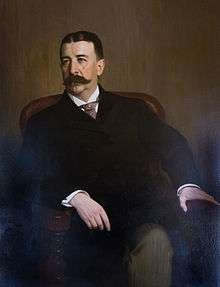Jared Bradley Flagg
Jared Bradley Flagg (June 16, 1820 – September 25, 1899) was an American painter from New Haven, Connecticut. He was the younger brother of artists George Whiting Flagg and Henry Collins Flagg III. His father, Henry Collins Flagg, was a one time mayor of New Haven.[1]
Education and training
The Flagg brothers all studied painting under their famous uncle, Washington Allston, and received some recognition of their own. When he was only sixteen years old, Jared exhibited a portrait of his father in the National Academy and was favorably noticed by the critics.
As a young man, Flagg settled in Hartford, Connecticut. However, he moved to New York in 1849 and was soon elected an academician. Jared pursued the study of theology at intervals with his art, and, in 1854, he entered the ministry of the Protestant Episcopal Church. Among his seven children was Ernest Flagg, who became a notable architect.[2][3]
Jared received the degree of A.M. from Trinity College in 1861, and that of S.T.D. from Columbia in 1863. For ten years he devoted himself to the discharge of his theological duties, then he returned to the practice of his art.
Notable works
Flagg occasionally painted ideal figure pictures but made portraits his specialty. Among Flagg's more notable portraits are of several of the judges of the New York Court of Appeals, including a three-quarter length of Chief Justice Sanford E. Church, which was placed in the new state capitol; a life-size full-length of William M. Evarts, also hung in the capitol (1887); and several portraits of Commodore Vanderbilt, one of which hangs in the directors' room at the Grand Central depot in New York. Other notable paintings by Jared Flagg include Holy Thoughts and Paul before Felix (1849), and Angelo and Isabella (1850).
Gallery
-

Flagg's official portrait of 43rd Rhode Island Governor Daniel Russell Brown hangs in the Rhode Island State House
-

Portrait of William M. Evarts (1887)
Real-estate developer
Beginning in 1881, Jared Flagg started organizing the syndicates behind the first co-operative apartment houses in New York City. He earned a reputation as a sharp dealer in this new kind of investment, where capital was raised from future occupants, who were sometimes easily fleeced with overly optimistic predictions.[4]
In 1882, Flagg acquired the lot next to the square leading to Central Park, the site of the present Plaza Hotel, intending to build "the largest and handsomest apartment house ever erected in this country." The idea of a luxury apartment building was essentially unknown at the time; the earliest co-ops were conceived as communal artists' dwellings.[5] Later that year, Flagg's project had fallen through, and his partners had backed out. After going through several architects, financial problems and ownership groups, the "Plaza" was finally completed as its present incarnation in 1907.[5]
References
- ↑ "Jared Bradley Flagg, 1820-1899". The Correspondence of James McNeill Whistler, Centre for Whistler Studies, University of Glasgow (2004). Retrieved 2007-05-19.
- ↑ Flagg, Ernest. Genealogical Notes on the Founding of New England: My Ancestors Part in that Undertaking. Hartford, Conn., 1926, p. 135.
- ↑ Flagg, Lucius C.S. Family Records of the Descendants of Gershom Flagg. Quincy, Ill., 1907, pp. 125, 128.
- ↑ Gray, C. (October 28, 1984). "The 'Revolution' of 1881 is Now in Its 2d Century". New York Times. Retrieved 2007-05-19.
- 1 2 Gray, C. (August 21, 2005). "The Plazas That Predate The Plaza". New York Times. Retrieved 2007-05-19.